Examining the Impact of Rotated Neck and Trunk Postures on Vertical Seat-to-Head Vibration Transmissibility and Self-Reported Discomfort
Abstract
1. Introduction
2. Materials and Methods
2.1. Participants
2.2. Experimental Set-Up
2.2.1. WBV Simulator
2.2.2. Postures
2.2.3. Posture Control
2.2.4. Video Game and Computer Screen Set-Up
2.3. Data Collection
2.3.1. Pre-Participation Questionnaire
2.3.2. Test Session Outline with Conditions
2.3.3. Measurement of Whole-Body Vibration
2.3.4. Discomfort Measurement
2.4. Data Analysis
2.5. Statistical Analysis
3. Results
3.1. Vertical Axis Seat-to-Head Transmissibility (STHT)
3.2. CSD Transfer Functions
3.3. Self-Reported Discomfort
4. Discussion
5. Conclusions
Author Contributions
Funding
Institutional Review Board Statement
Informed Consent Statement
Data Availability Statement
Acknowledgments
Conflicts of Interest
References
- ISO-2631-1; Mechanical Vibration and Shock—Evaluation of Human Exposure to Whole-Body Vibration—Whole-Body Vibration—Part 1: General Requirements. International Organization for Standardization: Geneva, Switzerland, 1997.
- Tak, S.; Calvert, G.M. The estimated national burden of physical ergonomics hazards among US workers. Am. J. Ind. Med. 2011, 54, 395–404. [Google Scholar] [CrossRef] [PubMed]
- Palmer, K.T.; Griffin, M.J.; Bendall, H.; Pannett, B.; Coggon, D. Prevalence and pattern of occupational exposure to whole body vibration in Great Britain: Findings from a national survey. Occup. Environ. Med. 2000, 57, 229–236. [Google Scholar] [CrossRef] [PubMed]
- Bovenzi, M.; Pinto, I.; Stacchini, N. Low back pain in port machinery operators. J. Sound Vib. 2002, 253, 3–20. [Google Scholar] [CrossRef]
- Paschold, H.W.; Sergeev, A.V. Whole-body vibration knowledge survey of U.S. occupational safety and health professionals. J. Saf. Res. 2009, 40, 171–176. [Google Scholar] [CrossRef] [PubMed]
- Nazerian, R.; Korhan, O.; Shakeri, E. Work-related musculoskeletal discomfort among heavy truck drivers. Int. J. Occup. Saf. Ergon. 2020, 26, 233–244. [Google Scholar] [CrossRef]
- WSIB. By the Numbers: Schedule 1—Injuries and Occupational Disease—Part of Body. Available online: https://www.wsib.ca/en/bythenumbers/schedule-1-injuries-and-occupational-disease-part-body (accessed on 27 December 2021).
- Paddan, G.S.; Griffin, M.J. A review of the transmission of translational seat vibration to the head. J. Sound Vib. 1998, 215, 863–882. [Google Scholar] [CrossRef]
- Mansfield, N.J. Review article: Impedance methods (apparent mass, driving point mechanical impedance and absorbed power) for assessment of the biomechanical response of the seated person to whole-body vibration. Ind. Health 2005, 43, 378–389. [Google Scholar] [CrossRef][Green Version]
- Adam, S.A.; Jalil, N.A.; Razali, K.M.; Ng, Y.G. The effects of posture on suspension seat transmissibility during exposure to vertical whole-body vibration. IOP Conf Ser. J. Phys. 2019, 1262, 1–8. [Google Scholar]
- Donati, P. A procedure for developing a vibration test method for specific categories of industrial trucks. J. Sound Vib. 1998, 215, 947–957. [Google Scholar] [CrossRef]
- Hoy, J.; Mubarak, N.; Nelson, S.; De Landas, M.S.; Magnusson, M.; Okunribido, O.; Pope, M. Whole body vibration and posture as risk factors for low back pain among forklift truck drivers. J. Sound Vib. 2005, 284, 933–946. [Google Scholar] [CrossRef]
- Bovenzi, M.; Rui, F.; Negro, C.; D’Agostin, F.; Angotzi, G.; Bianchi, S.; Bramanti, L.; Festa, G.; Gatti, S.; Pinto, I.; et al. An epidemiological study of low back pain in professional drivers. J. Sound Vib. 2006, 298, 514–539. [Google Scholar] [CrossRef]
- Eger, T.; Stevenson, J.; Callaghan, J.; Grenier, S.G. Predictions of health risks associated with the operation of load-haul-dump mining vehicles: Part 2—Evaluation of operator driving postures and associated postural loading. Int. J. Ind. Ergon. 2008, 38, 801–815. [Google Scholar] [CrossRef]
- Kim, J.H.; Dennerlein, J.T.; Johnson, P.W. The effect of a multi-axis suspension on whole body vibration exposures and physical stress in the neck and low back in agricultural tractor applications. Appl. Ergon. 2018, 68, 80–89. [Google Scholar] [CrossRef] [PubMed]
- Mansfield, N.J.; Maeda, S. Effect of backrest and torso twist on the apparent mass of the seated body exposed to vertical vibration. Ind. Health 2005, 43, 413–420. [Google Scholar] [CrossRef]
- Raffler, N.; Rissler, J.; Ellegast, R.; Schikowsky, C.; Kraus, T.; Ochsmann, E. Combined exposures of whole-body vibration and awkward posture: A cross sectional investigation among occupational drivers by means of simultaneous field measurements. Ergonomics 2017, 60, 1564–1575. [Google Scholar] [CrossRef]
- Newell, G.S.; Mansfield, N.J. Evaluation of reaction time performance and subjective workload during whole-body vibration exposure while seated in upright and twisted postures with and without armrests. Int. J. Ind. Ergon. 2008, 38, 499–508. [Google Scholar] [CrossRef]
- Zimmerman, C.L.; Cook, T.M. Effects of vibration frequency and postural changes on human responses to seated whole-body vibration exposure. Int. Arch. Occup. Environ. Health 1997, 69, 165–179. [Google Scholar] [CrossRef]
- Mansfield, N.J.; Griffin, M.J. Effects of posture and vibration magnitude on apparent mass and pelvis rotation during exposure to whole-body vertical vibration. J. Sound Vib. 2002, 253, 93–107. [Google Scholar] [CrossRef]
- Bhiwapurkar, M.K.; Saran, V.H.; Harsha, S.P. Effects of posture and vibration magnitude on seat to head transmissibility during exposure to fore-and-aft vibration. J. Low Freq. Noise 2019, 38, 826–838. [Google Scholar] [CrossRef]
- Wang, W.; Rakheja, S.; Boileau, P.-E. Effects of sitting postures on biodynamic response of seated occupants under vertical vibration. Int. J. Ind. Ergon. 2004, 34, 289–306. [Google Scholar] [CrossRef]
- Rahmatalla, S.; DeShaw, J. Effective seat-to-head transmissibility in whole-body vibration: Effects of posture and arm position. J. Sound Vib. 2011, 330, 6277–6286. [Google Scholar] [CrossRef]
- Kitzaki, S.; Griffin, M.J. Resonance behaviour of the seat human body and effects of posture. J. Biomech. 1998, 31, 143–149. [Google Scholar] [CrossRef]
- Jack, R.J.; Eger, T.R. The effects of posture on seat-to-head whole-body vibration transmission. J. Low Freq. Noise 2008, 27, 309–325. [Google Scholar] [CrossRef]
- Wikstrom, B.-O. Effects from twisted postures and whole-body vibration during driving. Int. J. Ind. Ergon. 1994, 12, 61–75. [Google Scholar] [CrossRef]
- Eger, T.; Dickey, J.P.; Boileau, P.-É.; Stevenson, J.M. Changes in seat-head whole-body vibration transmissibility and muscle activity under asymmetric neck and trunk postures. In Proceedings of the 2nd American Conference on Human Vibration, Chicago, IL, USA, 4–6 June 2008. [Google Scholar]
- Scutter, S.; Turker, K.S.; Hall, R. Headaches and neck pain in farmers. Aust. J. Rural. Health 1997, 5, 2–5. [Google Scholar] [CrossRef]
- Eger, T.; Stevenson, J.; Boileau, P.É.; Salmoni, A. Predictions of health risks associated with the operation of load-haul-dump mining vehicles: Part 1—Analysis of whole-body vibration exposure using ISO 2631-1 and ISO-2631-5 standards. Int. J. Ind. Ergon. 2008, 38, 726–738. [Google Scholar] [CrossRef]
- Smets, M.P.H.; Eger, T.R.; Grenier, S.G. Whole-body vibration experienced by haulage trick operators in surface mining operations: A comparison of various analysis methods utilized in the prediction of health risks. Appl. Ergon. 2010, 41, 763–770. [Google Scholar] [CrossRef]
- Griffin, M.J. Handbook of Human Vibration, 1st ed.; Academic Press: London, UK, 1990; p. 988. [Google Scholar]
- DeShaw, J.; Rahmatalla, S. Predictive discomfort in single- and combined-axis whole-body vibration considering different seated postures. Hum. Factors 2014, 56, 850–863. [Google Scholar] [CrossRef]
- Hamberg-Van Reenen, H.H.; Van Der Beek, A.J.; Blatter, B.M.; Van Der Grinten, M.P.; Van Mechelen, W.; Bongers, P.M. Does musculoskeletal discomfort at work predict future musculoskeletal pain? Ergonomics 2008, 51, 637–648. [Google Scholar] [CrossRef]
- Grenier, S.G.; Eger, T.R.; Dickey, J.P. Predicting discomfort scores reported by LHD operators using whole-body vibration exposure values and musculoskeletal pain scores. Work 2010, 35, 49–62. [Google Scholar] [CrossRef]
- Dickey, J.P.; Eger, T.R.; Oliver, M.L.; Boileau, P.E.; Trick, L.M.; Edwards, A.M. Multi-axis sinusoidal whole-body vibrations: Part 1—How long should the vibration and rest exposures be for reliable discomfort measures? J. Low Freq. Noise 2006, 25, 175–184. [Google Scholar] [CrossRef]
- Dickey, J.P.; Eger, T.R.; Oliver, M.L.; Boileau, P.E.; Trick, L.M.; Edwards, A.M. Multi-axis sinusoidal whole-body vibrations: Part 2—Relationship between vibration total value and discomfort varies between vibration axes. J. Low Freq. Noise 2007, 26, 195–204. [Google Scholar] [CrossRef]
- Patelli, G.; Griffin, M.J. Effects of seating on the discomfort caused by mechanical shocks: Measurement and prediction of SEAT values. Appl. Ergon. 2019, 74, 134–144. [Google Scholar] [CrossRef] [PubMed]
- Paddan, G.S.; Griffin, M.J. Transmission of yaw seat vibration to the head. J. Sound Vib. 2000, 229, 1077–1095. [Google Scholar] [CrossRef]
- European Parliament. Directive 2002/44/EC of the European Parliament and of the council on the minimum health and safety requirements regarding the exposure of workers to the risks arising from physical agents (vibration). Off. J. Eur. Communities 2002, 6, 13–19. [Google Scholar]
- Guide, B.S. BS 6841: Measurement and Evaluation of Human Exposure to Whole-Body Mechanical Vibration and Repeated Shock; BSI: London, UK, 1987; p. 24. [Google Scholar]
- SAE J898_199410; Control Locations for Off-Road for Machines. The Society of Automotive Engineers: Warrendale, PA, USA, 1994.
- Dempsey, T.K.; Leatherwood, J.D.; Clevenson, S.A. Development of noise and vibration ride comfort criteria. J. Acoust. Soc. Am. 1979, 65, 124–132. [Google Scholar] [CrossRef]
- Du, B.B.; Bigelow, P.L.; Wells, R.P.; Davies, H.W.; Hall, P.; Johnson, P.W. The impact of different seats and whole-body vibration exposures on truck driver vigilance and discomfort. Ergonomics 2018, 61, 528–537. [Google Scholar] [CrossRef]
- Kolich, M.; Wan, D.; Pielemeier, W.J.; Meier Jr, R.C.; Szott, M.L. A comparison of occupied seat vibration transmissibility from two independent facilities. J. Vib. Control 2006, 12, 189–196. [Google Scholar] [CrossRef]
- Kittusamy, N.K.; Buchholz, B. Whole-body vibration and postural stress among operators of construction equipment: A literature review. J. Saf. Res. 2004, 35, 255–261. [Google Scholar] [CrossRef]
- Pope, M.H.; Wilder, D.G.; Magnusson, M. Possible mechanisms of low back pain due to whole-body vibration. J. Sound Vib. 1998, 215, 687–697. [Google Scholar] [CrossRef]
- Paddan, G.S.; Griffin, M.J. Effect of seating on exposures to whole-body vibration in vehicles. J. Sound Vib. 2002, 253, 215–241. [Google Scholar] [CrossRef]
- Demic, M.; Lukic, J. Investigation of the transmission of fore and aft vibration through the human body. Appl. Ergon. 2009, 40, 622–629. [Google Scholar] [CrossRef] [PubMed]
- Guo, L.-X.; Teo, E.C.; Lee, K.K.; Zhang, Q.H. Vibration characteristics of the human spine under axial cycle loads: Effect of frequency and damping. Spine 2005, 30, 631–637. [Google Scholar] [CrossRef] [PubMed]
- Santos, B.R.; Larivière, C.; Delisle, A.; Plamondon, A.; Boileau P, É.; Imbeau, D.; Vibration Research Group. A laboratory study to quantify the biomechanical responses to whole-body vibration: The influence on balance, reflex response, muscular activity and fatigue. Int. J. Ind. Ergon. 2008, 38, 626–639. [Google Scholar] [CrossRef]
- Dunk, N.M.; Callaghan, J.P. Lumbar spine movement patterns during prolonged sitting differentiate low back pain developers from matched asymptomatic controls. Work 2010, 35, 3–14. [Google Scholar] [CrossRef] [PubMed]
- Nolan, A.J.; Govers, M.E.; Oliver, M.L. Effect of fatigue on muscle latency, muscle activation and perceived discomfort when exposed to whole-body vibration. Ergonomics 2021, 64, 1281–1296. [Google Scholar] [CrossRef] [PubMed]
- Milosavljevic, S.; Bergman, F.; Rehn, B.; Carman, A.B. All-terrain vehicle use in agriculture: Exposure to whole body vibration and mechanical shock. Appl. Ergon. 2010, 41, 530–535. [Google Scholar] [CrossRef] [PubMed]
- Seidel, H.; Blüthner, R.; Hinz, B.; Schust, M. On the health risk of the lumbar spine due to whole-body vibration—Theoretical approach, experimental data and evaluation of whole-body vibration. J. Sound Vib. 1998, 215, 723–741. [Google Scholar] [CrossRef]
- Song, J.T.; Ahn, S.J.; Jeong, W.B.; Yoo, W.S. Subjective absolute discomfort threshold due to idle vibration in passenger vehicles according to sitting posture. Int. J. Automot. Technol. 2017, 18, 293–300. [Google Scholar] [CrossRef]
- Mansfield, N.J.; Griffin, M.J. Non-linearities in apparent mass and transmissibility during exposure to whole-body vertical vibration. J. Biomech. 2000, 33, 933–941. [Google Scholar] [CrossRef]
- Zhou, Z.; Griffin, M.J. Response of the seated human body to whole-body vertical vibration: Biodynamic responses to mechanical shocks. Ergonomics 2017, 60, 333–346. [Google Scholar] [CrossRef] [PubMed][Green Version]
- Huang, Y.; Zhang, P. Subjective discomfort caused by vertical whole-body vibration in the frequency range 2-100 Hz. Ergonomics 2019, 62, 420–430. [Google Scholar] [CrossRef] [PubMed]
- Nawayseh, N.; Sinan, H.A.; Alteneiji, S.; Hamdan, S. Effect of gender on the biodynamic responses to vibration induced by a whole-body vibration training machine. Eng. Med. 2019, 233, 383–392. [Google Scholar] [CrossRef] [PubMed]

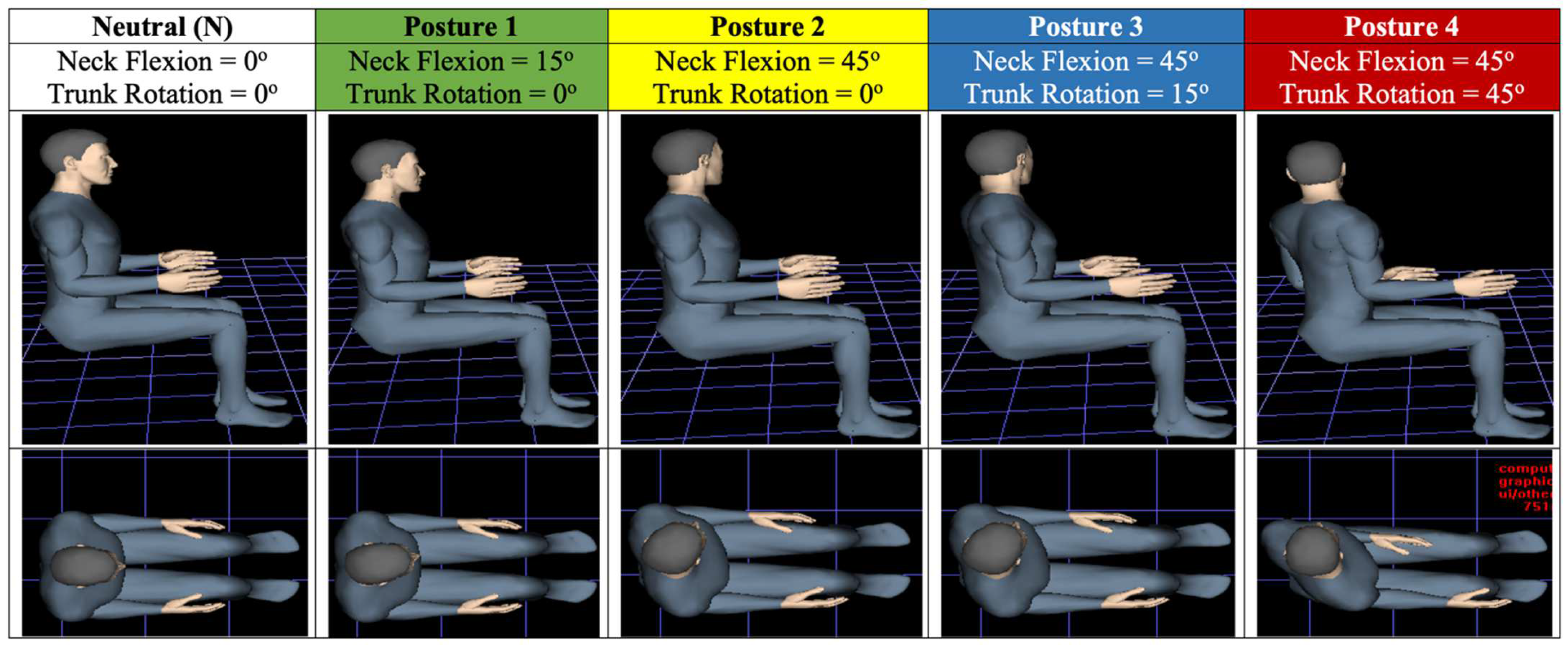

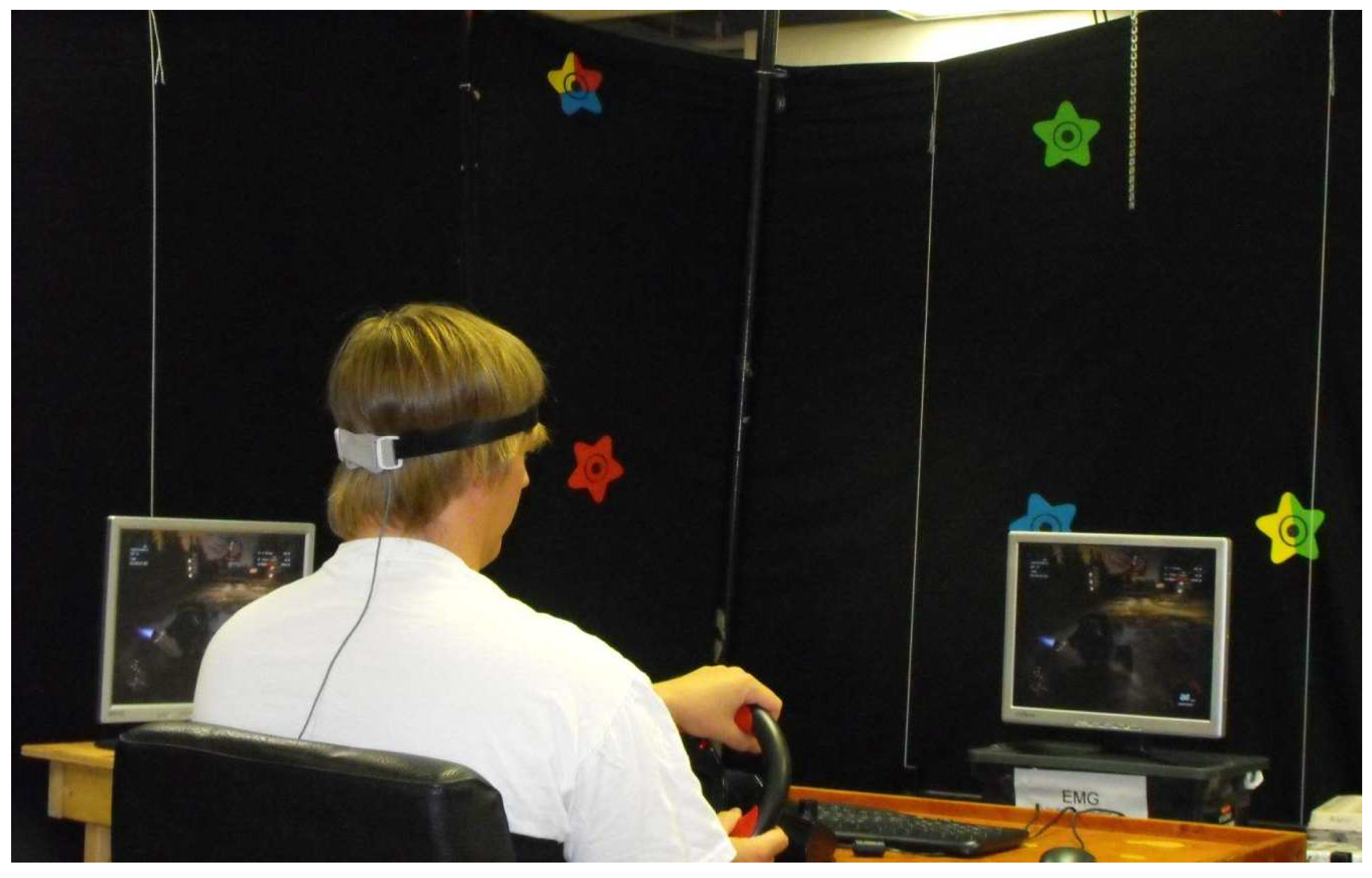
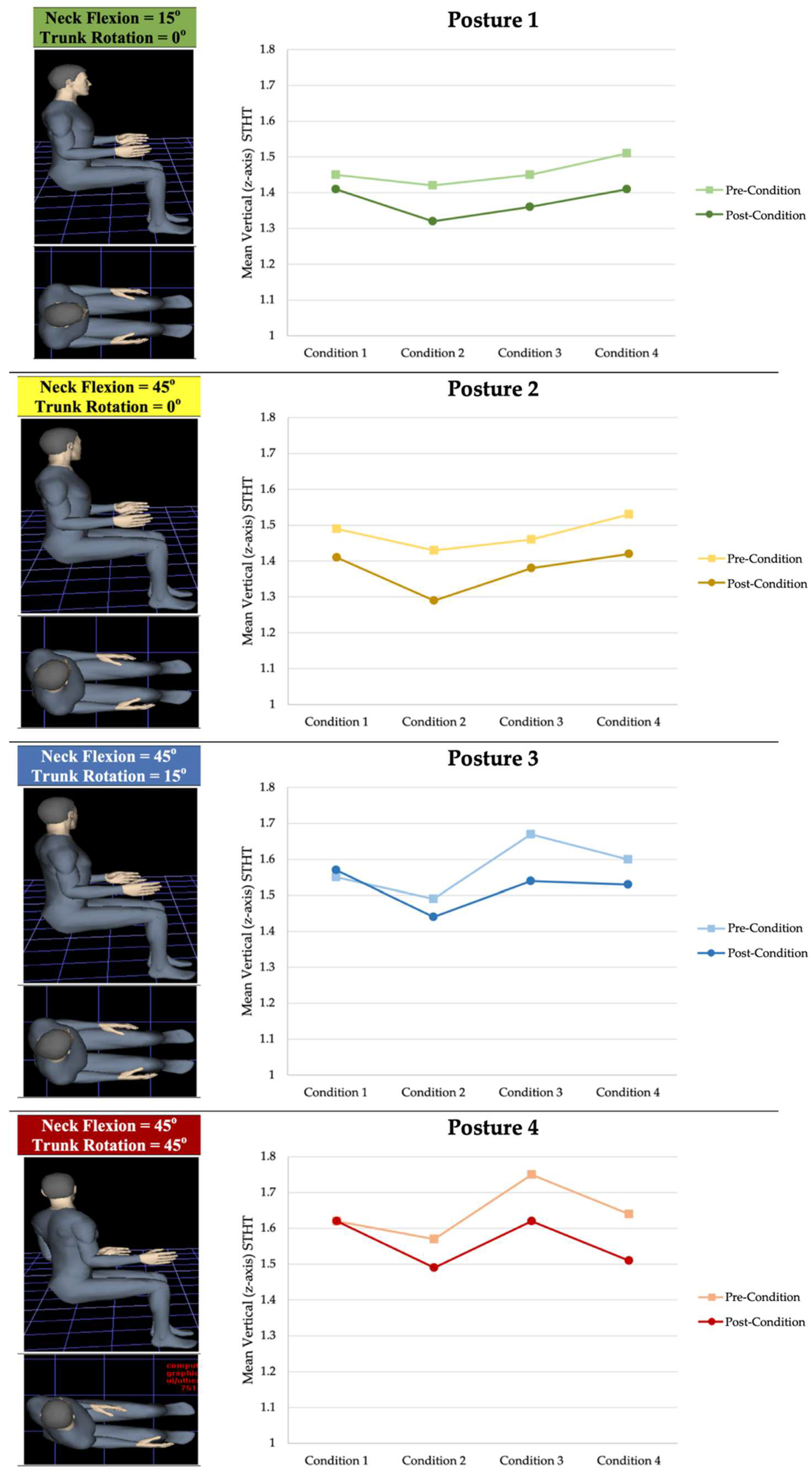
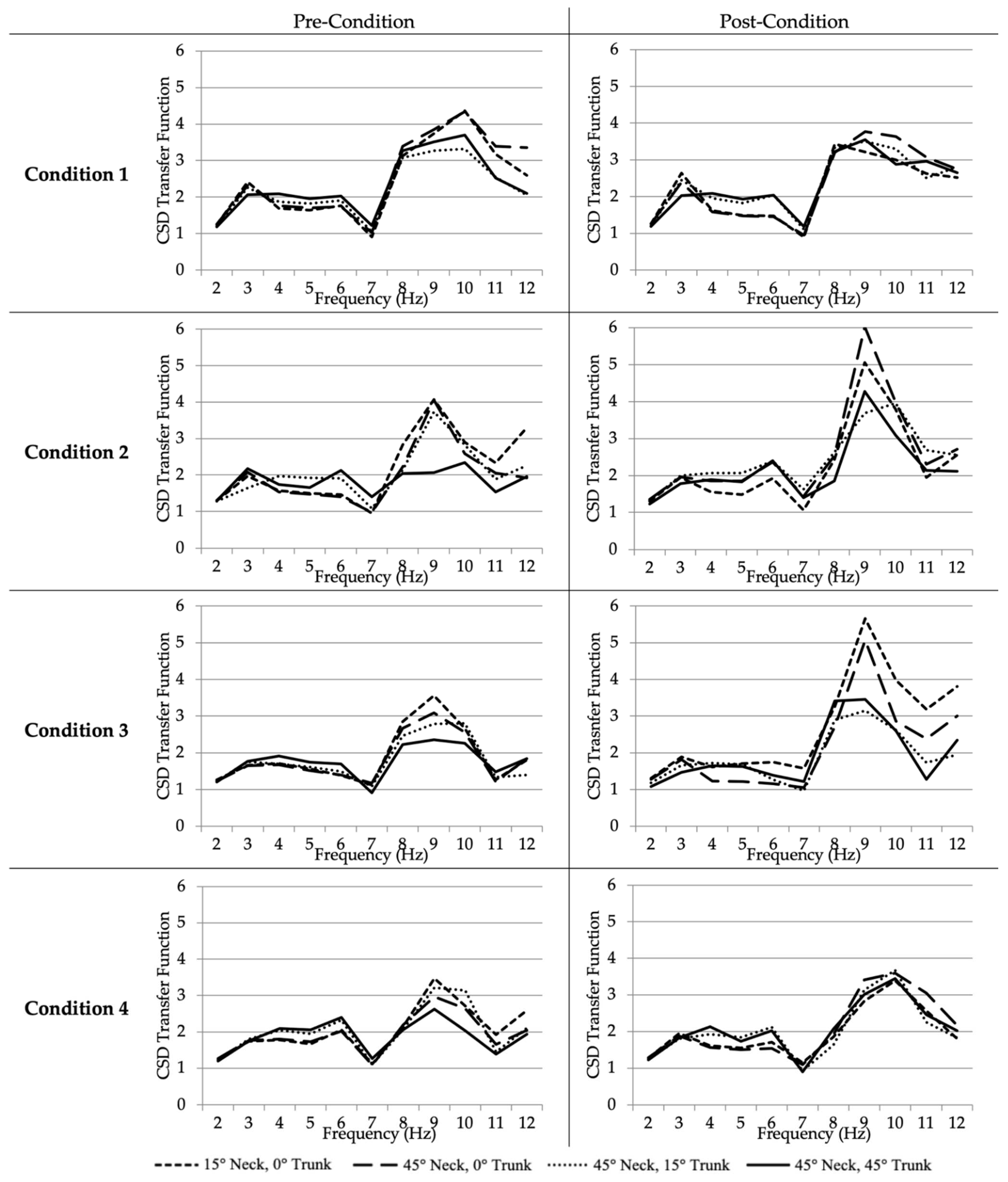
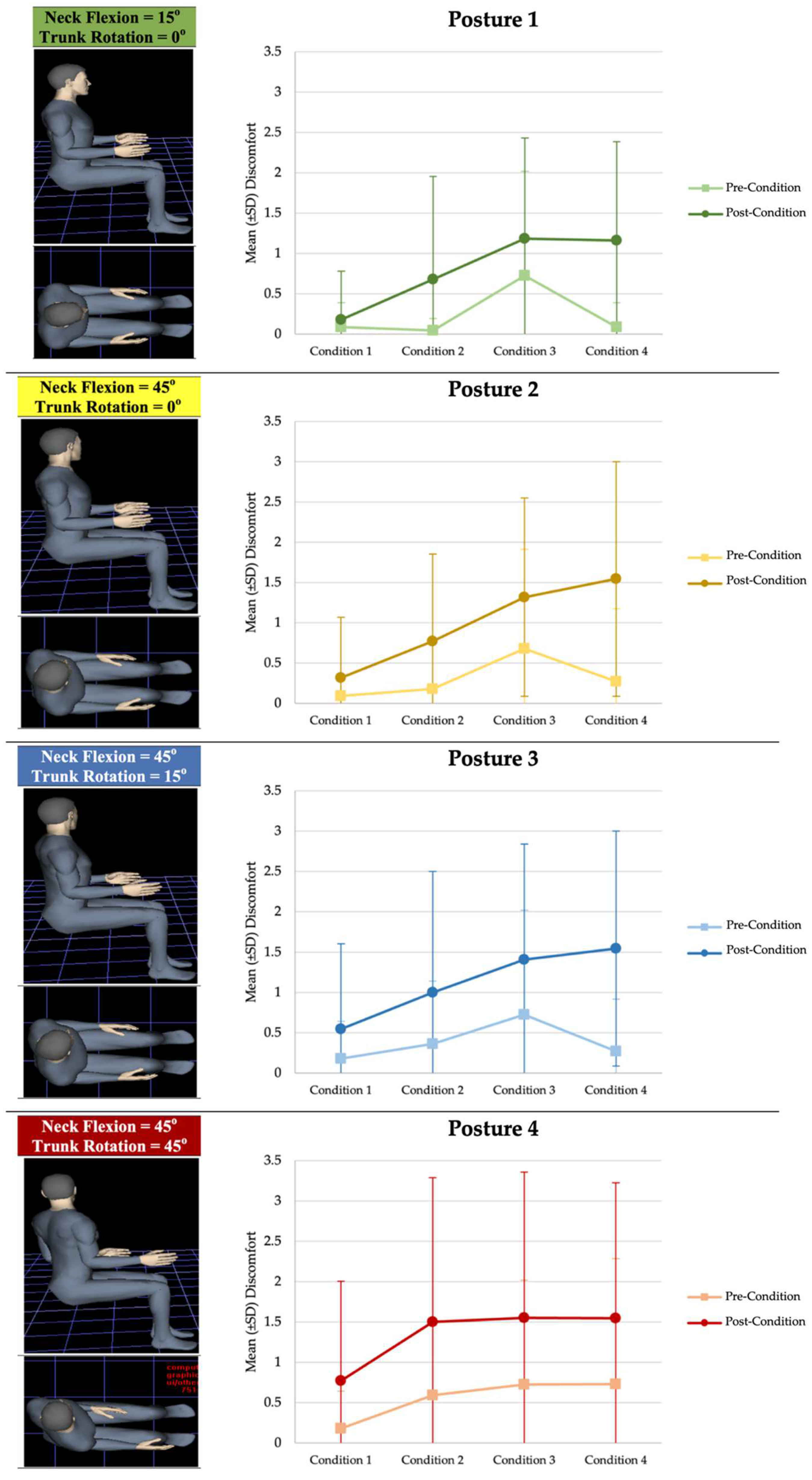
| Condition | ||||
|---|---|---|---|---|
| Posture | 1 (%) | 2 (%) | 3 (%) | 4 (%) |
| 15° Neck 0° Trunk | 2.76 | 7.04 | 6.21 | 6.62 |
| 45° Neck 0° Trunk | 5.37 | 9.79 | 5.48 | 7.19 |
| 45° Neck 15° Trunk | 1.29 | 3.36 | 7.78 | 4.38 |
| 45° Neck 45° Trunk | 0.00 | 5.10 | 7.43 | 7.94 |
Publisher’s Note: MDPI stays neutral with regard to jurisdictional claims in published maps and institutional affiliations. |
© 2022 by the authors. Licensee MDPI, Basel, Switzerland. This article is an open access article distributed under the terms and conditions of the Creative Commons Attribution (CC BY) license (https://creativecommons.org/licenses/by/4.0/).
Share and Cite
Goggins, K.A.; Kelly, E.A.; Thompson, T.J.; Eger, T.R. Examining the Impact of Rotated Neck and Trunk Postures on Vertical Seat-to-Head Vibration Transmissibility and Self-Reported Discomfort. Vibration 2022, 5, 306-325. https://doi.org/10.3390/vibration5020018
Goggins KA, Kelly EA, Thompson TJ, Eger TR. Examining the Impact of Rotated Neck and Trunk Postures on Vertical Seat-to-Head Vibration Transmissibility and Self-Reported Discomfort. Vibration. 2022; 5(2):306-325. https://doi.org/10.3390/vibration5020018
Chicago/Turabian StyleGoggins, Katie A., Elizabeth A. Kelly, Taryn J. Thompson, and Tammy R. Eger. 2022. "Examining the Impact of Rotated Neck and Trunk Postures on Vertical Seat-to-Head Vibration Transmissibility and Self-Reported Discomfort" Vibration 5, no. 2: 306-325. https://doi.org/10.3390/vibration5020018
APA StyleGoggins, K. A., Kelly, E. A., Thompson, T. J., & Eger, T. R. (2022). Examining the Impact of Rotated Neck and Trunk Postures on Vertical Seat-to-Head Vibration Transmissibility and Self-Reported Discomfort. Vibration, 5(2), 306-325. https://doi.org/10.3390/vibration5020018









